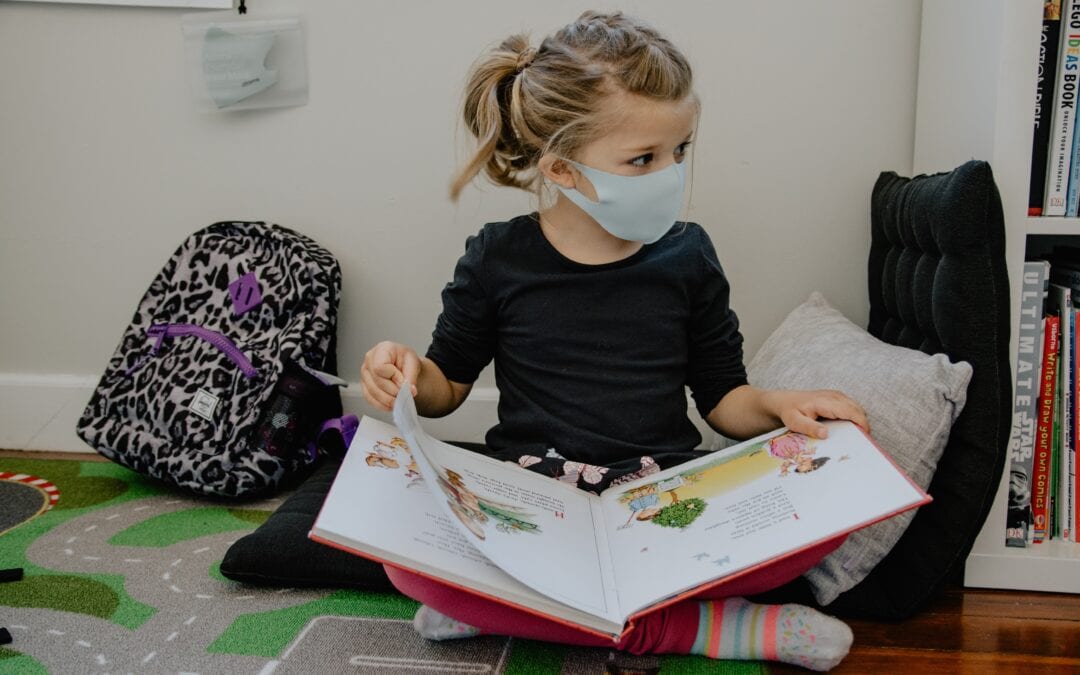With vaccines becoming readily available to adults across the country, many parents feel more confident about exploring what activities their children can safely participate in. Parents should take a close look at the safety measures businesses take to provide safe indoor environments and limit COVID-19 spread, especially among children.
At STEMful, we have taken every precaution possible to make sure children can enjoy learning in our safe indoor environment. We implemented safety measures informed by the latest data and science surrounding COVID-19, so parents can confidently enroll their children.
Our multilayered approach of practicing physical distancing, wearing face masks, regular hand washing, and vaccination, along with ventilation improvements and carbon dioxide (CO2) monitoring, reduces the spread of the virus and lowers the risk of infection.
Ventilation and Air Filtration
We prioritize ventilation in our indoor spaces at STEMful because it is one of the most impactful steps schools and programs can take to create safe indoor spaces for children and adults. The air in well-ventilated rooms is less likely to contain COVID-19 and, according to the Centers for Disease Control and Prevention (CDC), good ventilation reduces the spread of the virus.
HVAC and HEPA Filtration
To create the best ventilation possible at STEMful, we implemented a Heating, Ventilation, and Air Conditioning (HVAC) system with high-efficiency particulate air (HEPA) filters. Our HVAC system settings are optimized per CDC guidelines to improve indoor air quality by maximizing exchanges with outdoor air.
We’ve also added a Vornado Air Filter AC550, a portable HEPA filter, to each room in our educational studio. Based on the CDC and EPA recommendations, using portable HEPA filters as an adjunct to other ventilation and filtration techniques is the most effective way to reduce the risk of infection indoors. HEPA filters are 99.7% effective at clearing particles of 0.3 microns (µm) or above. COVID-19 particles ranging between 0.05-0.1 µm in size are often captured by HEPA filters because they often form clusters or attach to larger particulates in the air (such as from coughing or sneezing) and through a mechanism called diffusion.
The combined use of our HVAC system and portable HEPA filters completely replace the air in each room of our studio with fresh air every 10 minutes. This is known as air changes per hour (ACH). The higher the ACH, the lower the risk of COVD-19 infection in indoor environments. Each room in our studio has 8-16 ACH.
Air Circulation
As part of our best practices for ensuring a safe indoor space, we allow adequate time between indoor activities to allow fresh outdoor air to circulate. Air circulation via the HVAC system with the balanced use of window fans and open doors efficiently circulates fresh air for 30 to 60 minutes between programs. We take daily temperature, humidity, and wind factors into consideration when planning time between each program.
Air Quality Sensors for Safe Indoor Spaces
Low carbon Dioxide (CO2) level is an indication of good air quality. Carbon Dioxide is a gas we exhale when breathing, but it is also released from several different indoor sources such as equipment or devices that generates heat. Identifying these sources as well as knowing our local outdoor CO2 level help us establish our indoor CO2 baseline. For reference, Earth’s CO2 level is approximately 417 ppm as of March 2021, an increase from 2012 CO2 level of 400ppm.
When there is a high level of exhaled CO2 in an indoor space, there are more aerosols being released into the air through talking, laughing, coughing, sneezing, yelling, and singing. So if someone infected with a virus-like COVID-19 coughs in a room with poor air circulation, it is more likely that the risk is higher for others to get infected by breathing in contaminated aerosols. Studies recommend a CO2 threshold below 1100 ppm for indoor spaces.
To maintain low levels of CO2 in our indoor spaces at STEMful, we closely monitor CO2 levels with an AirVisual Pro Smart Air Quality Monitor. Using the monitor, we keep close tabs on CO2 and air quality, making adjustments to increase air exchanges as needed to keep our levels between 500-800 ppm. We continually exchange the outdoor air through our HVAC system and maintain open windows and doors (with other safety considerations).
The ability to maintain low CO2 between 500-800 ppm and ACH of 8-16 throughout our education studio, combined with the HVAC system and portable HEPA filters ensures safe and clean air quality indoors for our programs at STEMful.
Effective Face Mask Use
Our multilayered approach of monitoring CO2 levels with adequate air exchange and air filtration via the HVAC system, along with HEPA filters, are major applications inside our education studio. The use of masks, particularly masks that aid in containing exhaled aerosols, is also an essential tool in a comprehensive approach to mitigating COVID-19 infection.
While encouraging our students to wear their masks diligently is critical, it is even more important that they properly wear the right masks. Not all masks provide the same amount of adequate protection against COVID-19 when children are indoors. That is why at STEMful, our mask policy follows the latest mask-wearing guidance from the CDC.
Well-fitting Masks
When masks don’t properly fit around the face, respiratory droplets and aerosol can be released through the gaps between the mask and face, potentially spreading infection. When children and staff are indoors at STEMful, we encourage the use of well-fitting masks. Well-fitting masks also decrease the number of adjustments needed throughout the day. Each time we touch our mask, we should wash our hands to prevent the spread of germs.
Choose Masks With Multiple Layers
Requiring double-layered masks with a filter between the layers is another way to ensure that masks effectively reduce the spread of COVID-19 indoors at STEMful. Multi-layered masks can prevent respiratory droplets from escaping, adding another layer to our approach to reduce the risk of infection indoors.
Hand Washing
Diligently washing hands with soap has played a significant role in preventing COVID-19 since the beginning of the pandemic. Hand hygiene is important for adults and children alike, especially when we are indoors or when we prepare to drink and eat.
STEMful encourages frequent handwashing as part of every indoor and outdoor program and activity. According to the World Health Organization, it is essential to wash your hands with soap for at least 20 seconds after coughing or sneezing, using the bathroom, and after touching your mask. Handwashing after touching high-touch surfaces like doorknobs and handles is critical to preventing the spread of germs.
Physical Distancing
We know that the primary way COVID-19 is spread is when people are within six feet of each other for long periods and can exchange droplets. At STEMful, we encourage physical distancing as much as possible to minimize opportunities to spread the infection.
Over the past year, research has shown that physical distancing, proper mask-wearing, and frequent hand washing can minimize the risk of exposure indoors.
Conclusion
Creating safe indoor spaces is crucial to getting our children back to the activities they love and for parents to feel confident sending them. This is why at STEMful, we take every precaution possible to minimize exposure during our indoor programs by implementing our multilayered approach to mitigating the spread of Covid-19. We are confident that with these measures, children can learn, play, and have fun safely.
To learn more about our indoor classes and activities, visit our Program page.

